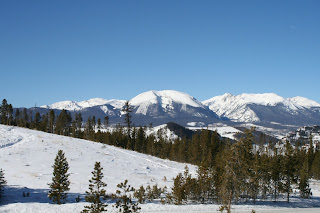As the bus exited the interstate, I noticed slopes surrounding the resort were snowcovered, although exposed bolders dotted the landscape as far as the eye could see.
 |
| River Coarse Nordic Center at Keystone. Ingrid and Sharon (right) are ready for trail. |
All doubts were erased as I stood on the steps of the nordic center, seeing nothing but a blanket of white in all directions.
Soon daypacks and snowshoes were secured and we were on trail.
Unlike summer hiking, pace is a non-issue for me when on snowshoes. After leaving the TH, it's more about awareness of my surroundings. One thing I've learned is to fully enjoy time in the backcountry. That means stopping often to focus on the glistening virgin powder, watch a squirrel jumping from branch to branch overhead, or follow the vapor trail left by a jet plane.
 |
| Snowshoer climbs to the ridge on Buffalo Trail. |
Most of the morning would be spent on the Buffalo trail. In terms of difficulty, it's rated as intermediate, with less than 100' elevation gain in two kilometers (1 mi., 427 yds.). Continuing on to the top of a ridge, the snow covered landscape opened up to provide a clear view of Keystone Mountain (11,835'), and in the distance, South Peak (11,982').
 |
| Scene form Buffalo and Aqueduct Trail junction of Williams Fork Mountains |
 |
| Mary Kay (first-timer), enjoys the day, followed by Ingrid and Sharon. |
 |
| Ed, Mary Kay, Ingrid, and Sharon on Aqueduct Trail. |
After descending the ridge, I continue on the Aqueduct Trail that wanders parallel with the Snake River on one side and Independence Mountain (12,641') on the other. I notice a handful of fellow snowshoers' are a few hundred yards ahead of me. I am now in a few more inches of powder as I push on for about another half mile.
 |
| White River National Forest. |
After stopping to capture a few images, I decide to retrace my tracks to Double Dare Trail. The 2.7 km (1 mi., 1,192 yds.) path is rated advanced and has a challenging 250' of elevation gain over that distance. More stops are made before reaching the top of a ridge. There, I notice a bench. A good spot to sit and rest.
A good day on trail may find 150 or more images on one 4GB chip. Photography is one element of my life that brings exceptional joy.
Distance is another part of snowshoeing that can vary from traditional hiking. A traditional dayhike may average 6 - 8 miles. The same hike on snowshoes may be half that distance.
 |
| Stepping into virgin powder. |
 |
| At first glance, you don't realize it's the 18th fairway marker. Pretty cool anyway. |
The Keystone Nordic Center offers visitors home made soup, warm rolls, and beverages. All-you-can-eat for one flat price. Today the aroma coming from a steaming pot of chicken chili made my decision easy. Before it was all consumed, the tingling in my extremities was gone.
Back outside, I decide to skirt the same ridge as I did this morning, only this time approach it from the opposite side. I was fortunate to have a trail of packed snow to begin but that soon dissipated and I was forced to cut virgin trail. For a snowshoer, there is no more exciting feeling than to be the first to break trail in a landscape blanketed with a thick white coat.
 |
| Tracks leading down from the ridge. |
No question, snowshoeing one mile in 8" of powder is more difficult than if I were hiking the same distance in a pair of hiking boots.
Temperatures in January tend to keep you moving in order to stay arm. Rest stops may be shorter but focus is needed to insure balance is maintained.
Regardless if you are walking on packed snow or breaking trail for the first time, there is no guarantee the next step you take will be on a totally stable surface. A tough crust can mask what apppears to be deep powder. Ice can be hidden by an inch of new snow. Each step on snowshoes should be taken with confidence and under control with the aid of poles for balance. Poles should be equipped with baskets to ensure maximum bouyancy while moving.

| There is no better feeling, on snowshoes, than breaking trail in the backcountry. |
Total miles: 2.3 (3.7 km)

No comments:
Post a Comment